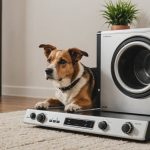Mastering the Art of Desensitizing Your Dog to Loud Noises: A Comprehensive Guide
Understanding the Importance of Noise Desensitization
Noise desensitization is a crucial aspect of dog training that can significantly impact your dog’s behavior and well-being. Loud noises, such as fireworks, thunderstorms, or even the doorbell, can cause anxiety and stress in dogs, leading to unwanted behaviors like barking, hiding, or even escaping. As a responsible dog owner, it’s essential to understand why noise desensitization is vital and how you can help your furry friend cope with these sounds.
The Impact of Loud Noises on Dogs
Dogs have a more sensitive hearing range than humans, which makes them more prone to noise-induced anxiety. For instance, the sound of fireworks can be particularly distressing due to its sudden and loud nature. Here’s what Dr. Karen Overall, a renowned veterinary behaviorist, has to say about noise phobias in dogs:
Additional reading : Mastering Noise: A Fun Guide to Help Your Dog Adjust to Loud Household Appliances
“Noise phobias are common and can be very distressing for dogs. They can lead to a range of behaviors from mild anxiety to full-blown panic attacks. It’s crucial to address these phobias through systematic desensitization and counterconditioning.”
Preparing Your Dog for Noise Desensitization
Before you start the desensitization process, it’s important to prepare both yourself and your dog. Here are some steps to ensure a smooth and effective training experience.
In the same genre : Mastering Agility: A Step-by-Step Guide to Training Your Papillon Puppy on an Exciting Dog Agility Course
Choosing the Right Time and Environment
When planning to desensitize your dog to loud noises, choose a time and environment that are least likely to cause additional stress. For example, avoid starting the training during peak hours of noise, such as during fireworks displays or thunderstorms. Instead, opt for quieter times of the day when your dog is more relaxed.
Selecting High-Value Treats and Rewards
High-value treats are essential in positive reinforcement training. These treats should be highly appealing to your dog, such as smelly or sticky treats like dog-friendly peanut butter or spray cheese. Here’s a tip from the American Kennel Club (AKC) on using treats effectively:
“Use high-value treats that take a little while for dogs to eat. This helps in keeping them focused and calm during the training sessions”.
Step-by-Step Guide to Desensitizing Your Dog
Desensitizing your dog to loud noises involves a gradual and systematic approach. Here’s a detailed step-by-step guide to help you through the process.
Desensitization to Specific Noises
Doorbell Desensitization
The doorbell is a common source of noise that can excite or stress dogs. Here’s how you can desensitize your dog to the doorbell sound:
- Initial Steps: Start by showing your dog a high-value treat while the doorbell rings. Praise your dog as they continue to lick the treat. Repeat this process several times until your dog becomes comfortable with the sound.
- Phase Out Treats: Once your dog is comfortable with the doorbell sound, try pushing the doorbell before giving the treat. Then, offer the treat and praise your dog as they remain calm.
- Teach a Command: Introduce a command like “go to bed” or “place” and use the treat to lure your dog to their bed or crate. When your dog is in bed, give them the treat and praise them.
- Consistency and Reinforcement: Consistency is key. Ensure that the doorbell ringing becomes the cue for your dog to go to their bed and wait to be treated. Keep a treat jar near the front door to quickly reward your dog if someone unexpectedly comes to the door.
Fireworks and Thunderstorm Desensitization
Desensitizing your dog to fireworks or thunderstorms requires a similar approach but with some additional considerations:
- Recorded Noises: Use recorded noises of fireworks or thunderstorms at a low volume initially.
- Gradual Increase: Gradually increase the volume over several training sessions.
- Positive Reinforcement: Reward your dog with treats and praise for remaining calm.
- Safe Space: Create a safe space for your dog where they can retreat during loud noises. This could be a quiet room or a crate with comfortable bedding.
Multiple Dog Considerations
If you have multiple dogs, especially an older dog and a new puppy, it’s important to train them separately to avoid unwanted behaviors being learned.
- Separate Training: Train each dog in a separate part of the house to prevent the puppy from learning unwanted reactions from the older dog.
- Gradual Integration: Once both dogs are successfully trained, you can slowly integrate them into the same training sessions.
Safety First: Preventing Unwanted Behaviors
Safety is paramount when teaching your dog to react calmly to loud noises. Here are some tips to ensure safety during the training process.
Preventing Escape
If your dog has a tendency to dart out of doors, keep them on a leash or use dog gates to create a barrier.
- Leashes and Gates: Use leashes or dog gates to prevent your dog from getting near the door when someone visits.
- Safe Areas: Designate safe areas where your dog can retreat during loud noises, such as a quiet room or a crate.
Practical Insights and Actionable Advice
Here are some practical insights and actionable advice to help you in your journey to desensitize your dog to loud noises.
Body Language
Pay attention to your dog’s body language. If your dog shows signs of stress or anxiety, such as panting, yawning, or hiding, it’s a sign that the noise is too loud or the training needs to be slowed down.
Consistency and Patience
Consistency and patience are key in any dog training. Desensitization to loud noises is a gradual process and may take several weeks or even months.
- Daily Sessions: Conduct daily training sessions, even if it’s just for a few minutes.
- Positive Reinforcement: Always use positive reinforcement techniques to encourage good behavior.
Education and Resources
Educate yourself on dog behavior and training techniques. There are numerous resources available, including books, online courses, and professional trainers.
- Professional Help: If your dog’s noise phobia is severe, consider seeking help from a professional dog trainer or a veterinary behaviorist.
- Online Resources: Utilize online resources such as the AKC and other reputable dog training websites for tips and guides.
Desensitizing your dog to loud noises is a rewarding process that can significantly improve your dog’s quality of life. By following the steps outlined in this guide, using positive reinforcement techniques, and being patient and consistent, you can help your furry friend feel more comfortable and secure in the presence of loud noises.
Final Tips
- Make It Fun: Make the training sessions fun and engaging for your dog.
- Be Patient: Be patient and go at your dog’s pace.
- Seek Help: Don’t hesitate to seek help if you need additional guidance or support.
By mastering the art of desensitizing your dog to loud noises, you are not only helping your dog but also strengthening the bond between you and your furry friend.
Detailed Bullet Point List: Steps for Desensitizing Your Dog to the Doorbell
- Initial Steps:
- Show your dog a high-value treat while the doorbell rings.
- Praise your dog as they continue to lick the treat.
- Repeat this process several times until your dog becomes comfortable with the sound.
- Phase Out Treats:
- Try pushing the doorbell before giving the treat.
- Offer the treat and praise your dog as they remain calm.
- Teach a Command:
- Introduce a command like “go to bed” or “place.”
- Use the treat to lure your dog to their bed or crate.
- When your dog is in bed, give them the treat and praise them.
- Consistency and Reinforcement:
- Ensure that the doorbell ringing becomes the cue for your dog to go to their bed and wait to be treated.
- Keep a treat jar near the front door to quickly reward your dog if someone unexpectedly comes to the door.
Comprehensive Table: Comparison of Training Methods for Different Noises
| Noise Type | Initial Steps | Gradual Increase | Positive Reinforcement | Safety Measures |
|---|---|---|---|---|
| Doorbell | Show treat while ringing | Phase out treats, introduce command | High-value treats, praise | Leashes, dog gates |
| Fireworks | Use recorded noises at low volume | Gradually increase volume | Treats, praise, safe space | Safe room, crate |
| Thunderstorms | Use recorded noises at low volume | Gradually increase volume | Treats, praise, safe space | Safe room, crate |
Relevant Quotes
- “Noise phobias are common and can be very distressing for dogs. They can lead to a range of behaviors from mild anxiety to full-blown panic attacks. It’s crucial to address these phobias through systematic desensitization and counterconditioning.” – Dr. Karen Overall
- “Use high-value treats that take a little while for dogs to eat. This helps in keeping them focused and calm during the training sessions.” – American Kennel Club (AKC)










